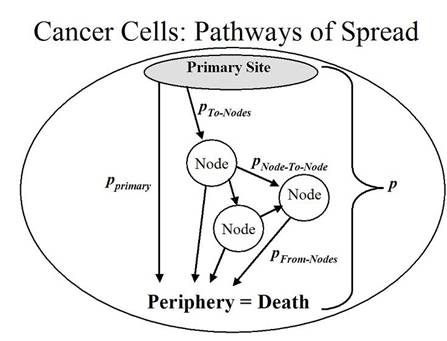Next: Tumor size and cancer mortality
The model of the spread of cancer cells

| Pathways of the Spread of Cancer Cells and their Probabilities | |||
|---|---|---|---|
| Pathway of spread | Seen in: | Fraction of patients with a manifestation of spread | Probability of spread, per cell |
| Lethal spread from the primary site to the periphery (directly only) | Fraction of patients dying (15-year Kaplan-Meier cancer death rate) among node-negative patients |  |
 |
| Non-lethal spread from the primary site to the local lymph nodes | The fraction of patients with positive nodes |  |
 |
| Lethal spread from the lymph nodes to the periphery | Lethal contribution per positive lymph node | - |  |
| Non-lethal spread from lymph node to lymph node | The numbers of positive positive nodes ( ) ) |
- |  |
Lethal spread from the primary site to the periphery (The aggregate consequence of the pathways of spread characterized by  , ,  , and , and  |
Fraction of patients dying (15-year Kaplan-Meier cancer death rate) among all patients |  |
 |
Let us define  as the fraction of patients who display a manifestation of the spread of cancer cells:
as the fraction of patients who display a manifestation of the spread of cancer cells:  will be the fraction of patients with cancer in the lymph nodes,
will be the fraction of patients with cancer in the lymph nodes,  will be the fraction of node negative patients dying of cancer and
will be the fraction of node negative patients dying of cancer and  will be the fraction of all patients who die of cancer. For reasons outlined above,
will be the fraction of all patients who die of cancer. For reasons outlined above,  and
and  are defined in terms of the 15-year cancer-specific Kaplan Meier death rate.
are defined in terms of the 15-year cancer-specific Kaplan Meier death rate.
Let us examine macroscopic feature of cancer - tumor size, nodal status, and cancer survival - in terms of the underlying microscopic spread of cancer cells, occurring with a definable probability of spread per cell,  . Thus
. Thus  shall be defined as the probability of a single successful event of spread for each of the
shall be defined as the probability of a single successful event of spread for each of the  cells from which the event of spread originated. It follows that
cells from which the event of spread originated. It follows that  is the probability of a single successful event of spread to the nodes for each of the
is the probability of a single successful event of spread to the nodes for each of the  cells in a primary tumor (thus corresponding to
cells in a primary tumor (thus corresponding to  ) while
) while  is the probability of a single successful lethal event of spread to periphery for each of the
is the probability of a single successful lethal event of spread to periphery for each of the  cells in a primary tumor in node negative patients (corresponding to
cells in a primary tumor in node negative patients (corresponding to  ) and
) and  is the probability of a single successful lethal event of spread to periphery for each of the
is the probability of a single successful lethal event of spread to periphery for each of the  cells in a primary tumor in all patients in the population, regardless of nodal status (corresponding to
cells in a primary tumor in all patients in the population, regardless of nodal status (corresponding to  ). Let us also define
). Let us also define  as the probability of a lethal event of spread from a lymph node to the periphery, and
as the probability of a lethal event of spread from a lymph node to the periphery, and  as the probability of a non-lethal event of spread from lymph node to lymph node.
as the probability of a non-lethal event of spread from lymph node to lymph node.